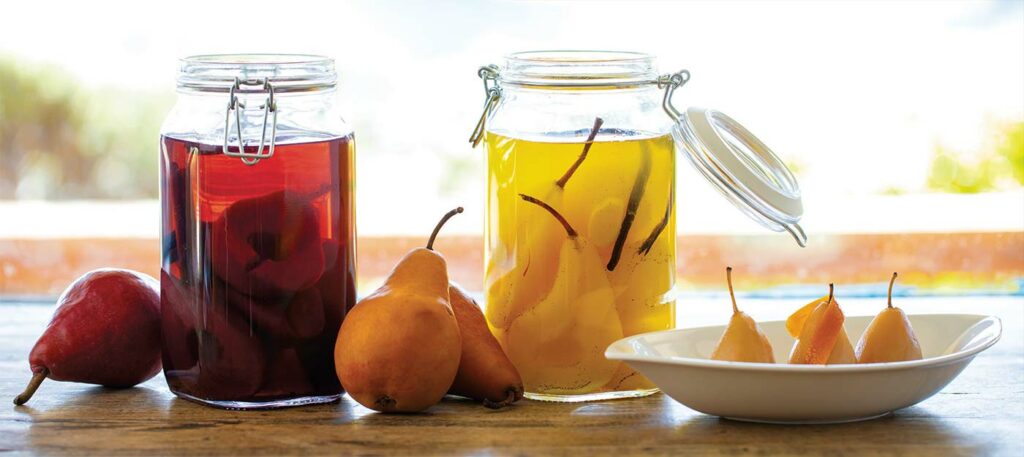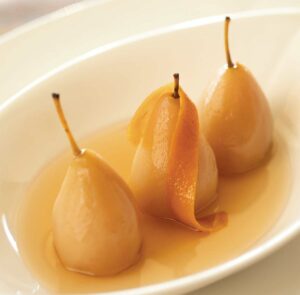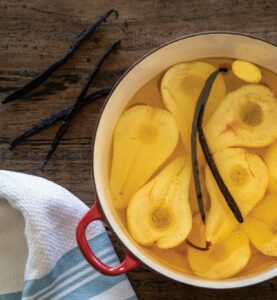
Forget the partridge, but amp up holiday meals with these jewels
PHOTOGRPAHY BY PATRICK TREGENZA
Only a handful of fruits can stand up to cooking without losing themselves in the process, and pears are the perfect example.
Pears have a funny way of stopping the conversation. When you bite into a perfectly ripe, juicy, fragrant pear your mind tends to wander, regardless of the circumstances— reminding you of the pleasure that something so simple can bring. Maybe that’s because life is complicated and a dreamy pear is hard to come by.
To achieve the perfect ripeness, staring at them longingly won’t do. Other than having a glorious pear tree in your backyard, you will need to find the balance between room temperature and refrigeration. Pears also don’t like crowding and they bruise easily, so while they look charming in a bowl, don’t pile them up.
Then there is the collection of different varieties. The Bosc is a heartier pear, with a long, elegant shape and a skin that can go from a velvety matte brown to an almost golden hue when ripe. They are crisp but can get mealy if not eaten at the right time. One of the most easily found varieties is the Bartlett, a sweet pear that goes from a lively green to yellow as it ripens, but can also get grainy if left uneaten for too long. The comice is similar but sweeter. The highly floral and juicier d’Anjou has green and red versions that make pretty combinations. And tiny forelles are firm even when ripe, are brightly acidic and have a reddish blush with a green background that is just beautiful. From fall to late winter, there are always fascinating varieties of pears to try.
The recommended check for ripeness is to gently press near the pear’s stem. It is tricky to find the perfect point of ripeness that balances acidity and aromatic notes while oozing juicy sweetness, but that’s where the magic of a poached pear lies.
There are only a handful of fruits that can stand up to cooking without losing themselves in the process, and pears are the perfect example. The floral notes that mostly define their flavor profile tend to shine here; after all, they are a member of the rose family, a great gene pool indeed. They have many other interesting nuances that can be emphasized or contrasted by adding additional flavors to the mix. All varieties work well for poaching, but take care when cooking Bartlett pears as they soften quickly.
For the French, poached pears are one of the first basic desserts to learn, and a great building block to have handy for more ambitious projects. It is possible to travel many flavor routes, all starting with poached pears, and they don’t even need to be ripe.
The indisputable classic is to poach pears in sweetened spiced red wine. The obvious turn is cinnamon, but there are many harmonious variations, like star anise, cardamom, black pepper, nutmeg, vanilla and clove. All, or any combination of them, tend to go well especially when using a fruity red wine, such as a merlot or even a substantial cabernet, as the background canvas.
Another great base is a bold acidic white wine, preferably without oaky notes. Brandy, port and sherry are also wonderful. Pears also match very well with saffron, ginger, vanilla and—if using great restraint—rosemary.
Almonds, walnuts, raspberries, buttery caramel and cheeses are excellent complements, so serve them alongside your poached pears, maybe in cookie or sauce form.
If none of those flavor routes strikes your fancy, there is always bacon. Sauté bacon and pears together and serve atop a salad. There is so much to explore.



About the author
Analuisa Béjar loves exploring flavor routes as the chef at her Sunny Bakery Cafe in Carmel Valley. She is a recent transplant from Mexico City, where she was a food critic, award-winning writer, editor, recipe developer, culinary teacher and organizer of Latin American gastronomy competitions.
- Analuisa Béjarhttps://www.ediblemontereybay.com/author/analuisabejar/
- Analuisa Béjarhttps://www.ediblemontereybay.com/author/analuisabejar/
- Analuisa Béjarhttps://www.ediblemontereybay.com/author/analuisabejar/
- Analuisa Béjarhttps://www.ediblemontereybay.com/author/analuisabejar/


